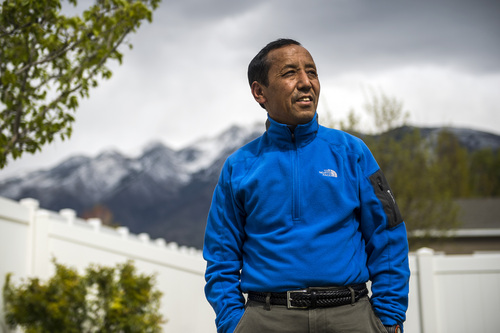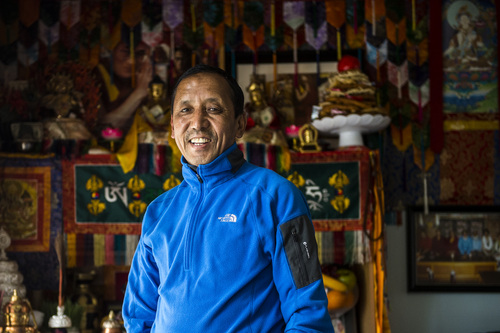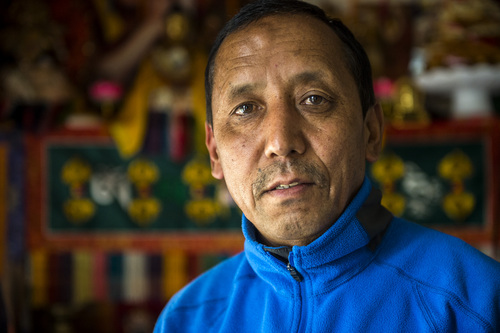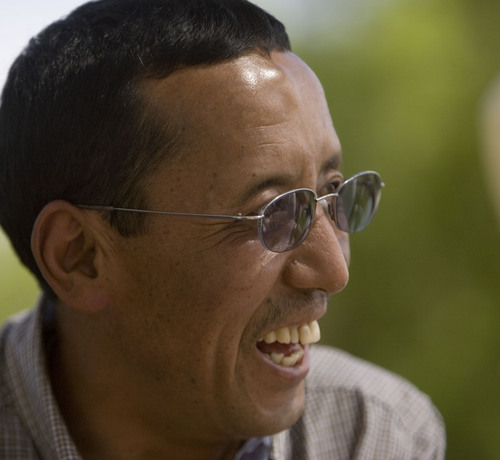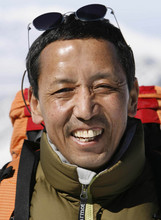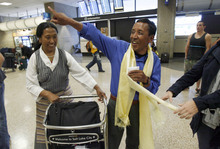This is an archived article that was published on sltrib.com in 2014, and information in the article may be outdated. It is provided only for personal research purposes and may not be reprinted.
The best advice Apa Sherpa ever received during his run to become the world record holder for summits on Mount Everest came the year someone told him not to go for the top.
It was 1996, and Rob Hall had asked Apa to join him on the expedition that, until this year, was recognized as the most deadly on the mountain.
The suggestion came from Yangjin Sherpa, Apa's wife. She told him he had tested the mountain enough in previous years, and it was time to let it rest.
Apa stayed home with his family while Hall and seven others died after being caught in a blizzard at the highest point on the planet. In all, 15 people died trying to summit Mount Everest in 1996.
A new high for deaths on the mountain happened this month in a single event when 16 people — all Sherpas — died in a large avalanche on April 18.
Apa now shares his advice, similar to his wife's counsel years ago, for people still considering making a run for the top of Everest as the peak window for reaching the summit approaches.
"It feels like the mountain needs to rest," Apa said from his Draper home after returning this weekend from a trip to Nepal for the Apa Sherpa Foundation. "Too many people are climbing. Leave Everest alone. Everest will always be there. The mountain isn't going anywhere. They can try next year."
Many Sherpas have already gone home, and expeditions are being canceled.
Apa, who has reached the top of the world 21 times, was far from the mountain in Kathmandu when he first heard of the deadly avalanche in the Khumbu Icefall that killed 16 and left nine injured.
He ended up at a temple, where family members of some of the Sherpa men killed in the avalanche gathered to mourn.
"It was very sad. There was nowhere for them to run when it happened," Apa said of the snowslide, which killed four people from his home village of Thame in the Himalayan Highlands.
"All of them are my friends. They had families, wives and children," he said. "They all know how dangerous it is, but they have to do it to take care of their families."
Apa knows well the draw of the mountain for the Sherpa people. Life is hard in the Himalayas. What little farming that can be done is challenging. He, like so many Sherpa people, watched as a young boy as well-outfitted expeditions headed for the mountain. Apa eventually landed a job helping deliver gear to base camp. His strength — despite being just 5-foot-4 and 120 or so pounds — smile and character eventually led to him being invited to help clients get to the top.
He made it for the first time in 1990 and didn't stop until his 21st summit in 2011.
Apa often says the Khumbu Icefall is the most dangerous part of the Everest climb. The shifting ice creates an ever-changing maze of crevasses spanned by ladders that climbers walk across.
The Khumbu is also prone to avalanches. In 2009, Apa lost a Sherpa member of his team in the icefall when an avalanche carried the man away. The team found only one of the man's shoes, with a sock still in it, and his backpack.
Apa, who made a more than 1,000-mile trek on the Great Himalaya Trail to raise awareness of the impacts of global climate change, says he worries that warming temperatures could increase the risk of climbing the mountain.
"The winters are still very cold, but only for a short time. It is warmer for a longer time," Apa said. "That is a big problem for climbers with more rockfalls and avalanches."
Global climate change, according to Apa, is not only a threat to climbers, but also to residents of the Himalayan foothills.
Apa experienced the threat firsthand when his own remote village of Thame was flooded after a glacial dam broke. He fears similar events will continue across the Himalayas as global climate change increases.
He was in Nepal when the avalanche happened, delivering computers and checks to remote schools as part of his work with his foundation. The checks will pay the salaries of two teachers for a year and provide schools with supplies, including money for desks.
It is highly likely, he said, that children or grandchildren of men killed in the avalanche will benefit from the foundation's contributions.
"The Sherpas do all the hard work and they were the only ones taken in this tragedy. They are doing this because they have no education; no other choice to make money," Apa said. "With an education they have a choice. Our goal is to give the younger generation a chance to go to school so they don't have to climb."
Because of his success as a sidar — expedition leader — Apa realized his goal of giving his children options other than climbing to make a living. He was able to pay for his children to attend school first in Thame and then in a private school in Kathmandu. But the school was far away, and Apa rarely saw his kids.
A trip to Utah for the annual mega Outdoor Retailer Convention provided Apa with connections to help his dream come true of being with his children and seeing them educated at the same time.
He moved the family to Utah in winter 2006. They remain Utah residents with strong connections to their Sherpa and Nepali roots.
While Apa believes all expeditions on Everest should pack up and head home to honor the men who died, he says he would not be surprised if some Sherpas end up helping teams that decide to stay and attempt the summit.
"I am not sure what is happening, but I would tell everyone to go home. This is the biggest tragedy we have seen," he said. "This is about respect for the men who died and for the mountain. Still, I know some may help. They will risk their lives for their families."
Twitter: @BrettPrettyman —
How to help: Ski on May 26
Snowbird Ski and Summer Resort, in partnership with the Human Outreach Project, is raising money to benefit the 16 families of the Sherpas killed in the recent avalanche on Mount Everest. A portion of the price of every lift ticket sold May 26 will be donated to the families.
Live music and special events will take place on the Snowbird Center Plaza Deck from 2 p.m. to 6 p.m.
Direct donations can be made here to the Human Outreach Project Sherpa Disaster Relief Fund. —
Apa's trips to the top of the world
18. May 22, 2008
16. May 19, 2006
15. May 31, 2005
14. May 17, 2004
13. May 26, 2003
12. May 16, 2002
11. May 24, 2000
10. May 26, 1999
9. May 20, 1998
8. April 26, 1997
7. May 15, 1995
6. Oct. 10, 1994
5. May 10, 1993
4. Oct. 7, 1992
3. May 12, 1992
2. May 8, 1991
1. May 10, 1990
Source: Apa Sherpa





